IEC 61937-3:2007 pdf download – Digital audio – Interface for non-linear PCM encoded audio bitstreams applying IEC 60958 – Part 3: Non-linear PCM bitstreams according to the AC-3 and enhanced AC-3 formats
It is recommended that pause data-bursts be used to fill stream gaps in the AC-3 bitstream, as described in IEC 61 937-1 , and that pause data-bursts be transmitted with a repetition period of three IEC 60958 frames, except when other repetition periods are necessary to fill the precise stream gap length (which may not be a multiple of three IEC 60958 frames), or to meet the requirement on burst spacing (see IEC 61 937-1 , 6.3.3).
When a stream gap in an AC-3 stream is filled by a sequence of pause data-bursts, the Pa of the first pause data-burst shall be located one frame repetition period following the Pa of the previous AC-3 frame.It is recommended that the sequence(s) of pause data-bursts which fill the stream gap should continue from this point up to (as close as possible considering the three IEC 60958 frame length of the pause data-burst) the Pa of the first AC-3 data-burst which follows the stream gap.
The gap length parameter contained in the pause data-burst is intended to be interpreted by the AC-3 decoder as an indication of the number of decoded PCM samples which are missing (due to the resulting audio gap). If the sizes of the AC-3 frames before and after the stream gap are not equal (due to a bitrate change in the interrupted AC-3 bitstream), this value may differ from the actual number of sampling periods of the audio contained in the stream gap due to the definition of the AC-3 burst reference points. Some AC-3 decoders may be capable of “concealing” audio gaps.
The indication of the audio gap length (gap-length) which may be included in the payload of the pause data-burst allows the decoder to know how long an audio gap will need to be concealed, and thus allow the decoder to optimize the concealment process for the actual audio gap length. AC-3 decoders will most easily conceal audio gaps that have a length equal to an integral multiple of 256 samples. Thus, audio gaps of lengths 256, 51 2, 768, etc. sampling periods of the audio are strongly preferred, and transmitters should provide stream gaps that represent audio gaps with this granularity.
It is possible that an audio gap in an AC-3 stream is carried over this interface without there also being a stream gap. This can happen when the audio gap length is small and there is a bit rate change in the interrupted AC-3 bit stream, and the bit rate following the gap is larger than the bit rate prior to the gap. Because of the definition of the reference point of the AC-3 data burst, it is possible for the Pa of the first burst following a bitstream interruption to be less than frame repetition period of the audio following the Pa of the burst preceding the gap, while the reference point of the first burst following the bit stream interruption is more than one frame repetition period of the audio after the reference point of the burst preceding the gap. When this case occurs, since there is no stream gap to fill with pause bursts, there is no need to send any pause bursts. The audio decoder will never be starved for data and can calculate the length of the audio gap based on the reference points of the received AC-3 bursts.
5.3.3 Enhanced AC-3 data An enhanced AC-3 bitstream is constructed from one or more substreams, with each substream being constructed from a sequence of enhanced AC-3 frames. An enhanced AC-3 frame is constructed from blocks of audio data, each block representing 256 samples of audio of each encoded audio channel (left, centre, etc.). An enhanced AC-3 frame can consist of one, two, three, or six blocks of audio data. The number of blocks per enhanced AC-3 frame is the same for all substreams present in the bitstream and is constant for the duration of the bitstream.
